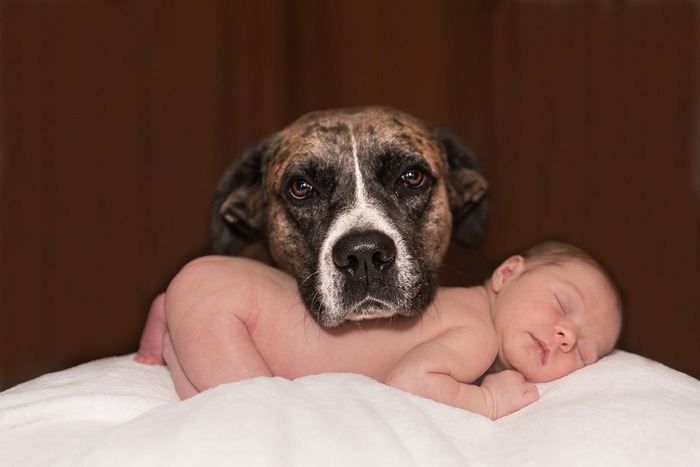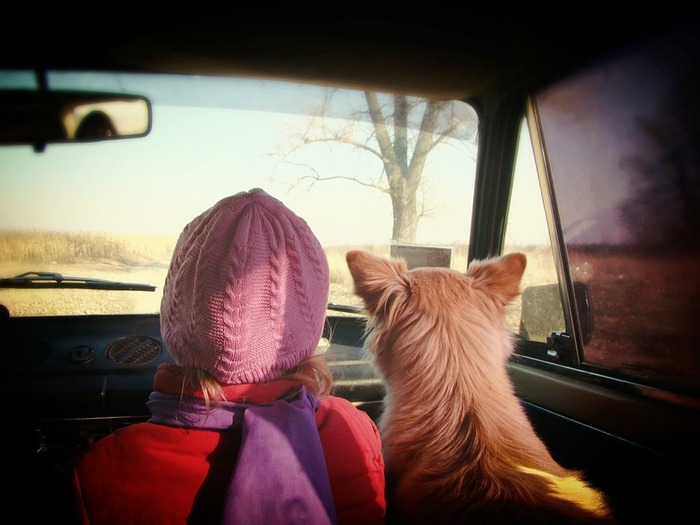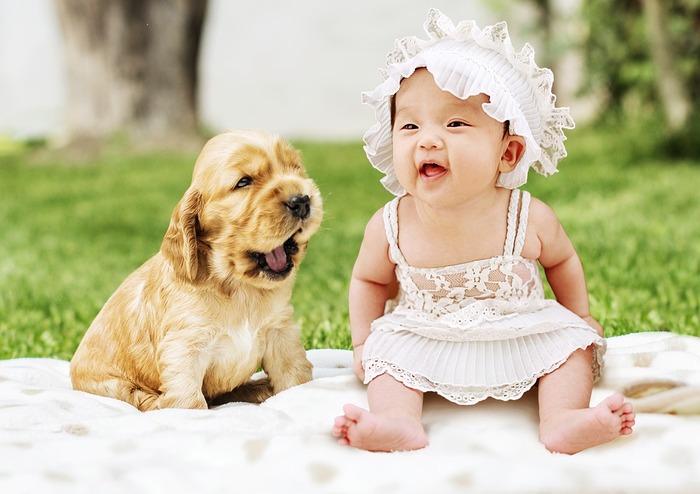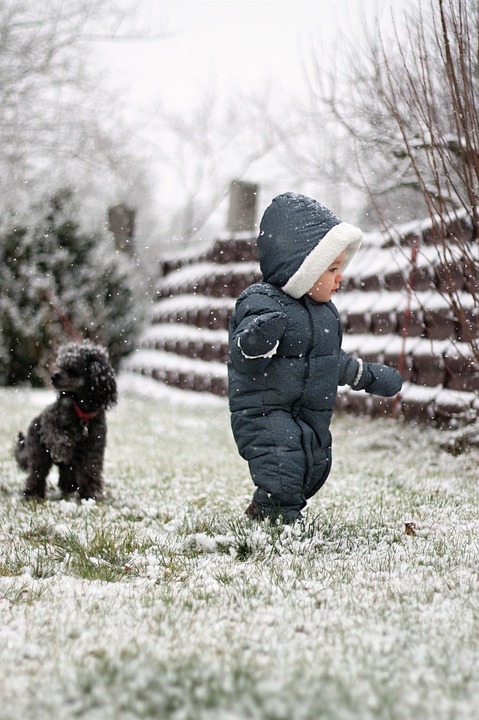2023-07-03
Welcoming a baby is one of the greatest experiences we as humans can have. We give our best to protect our newborns and ensure that they lead a happy life in a safe and loving environment. This might sound familiar to those of you who are already dog owners and who perceive their paw friends as family members, who deserve nothing but the best.
What will happen when your paw friend meets his/her new human family member? We all hope for the best, i.e. that they will hit it off immediately, and will develop a strong bond for a lifetime. In many cases, this is exactly what is going to happen, while in others we may have a bit of a different experience.
Today we will talk about the relationship between babies and dogs and what steps we can take to ensure a smooth and easy interaction between them.

Dogs have a strong pack instinct, which contributes to developing a strong bond with their family members. Having said that, it would be natural for your canine to want to protect the baby as it is perceived as the weakest member of the pack.
You may notice your paw friend sniffing at his/her new family member and/or licking it. You do not have to worry, as your dog is likely to mimic the behavior his/her mother has shown to her puppies. This is a common behavior in dogs, and it shows care, and affection and can be considered a sort of “health checking”.
Dogs, especially during the puppy phase or when representatives of energetic breeds, find in a baby a playmate, with whom they can spend a pleasant and fun time together. Let’s not forget about the attention that babies give dogs as they enjoy their company. A clingy dog would genuinely enjoy getting a lot of attention.
According to studies babies can greatly benefit from growing up around a paw friend. These benefits can be both physical and emotional. In regard to the physical aspect-babies tend to become more resistant to allergies and are likely to strengthen their immune system. When it comes to the emotional aspect, children who have grown up in a home with a paw friend, are likely to feel safer, protected, and loved, which results in lower stress levels. Interaction with a pup itself causes the hormones of happiness dopamine and serotonin to be produced.
If you want to make sure that there is a big chance of your dog accepting the new family member, you should take action in advance.
Knowing basic obedience is essential for all dogs, especially if you are considering training your paw friend in more advanced tasks in the future. e.g. service dog tasks. Basic obedience tasks like “sit”, “stay”, “leave”, “go to your spot”, and “away”, can be very beneficial for the proper socialization of a dog and his/her manners when being around a baby. This will help you train him/her to respect the boundaries you might set in the future during the first months of your baby’s life. Do not wait for the moment to come when your dog will finally meet your baby, to start training him/her in basic obedience.

As mentioned above, in most cases dogs get along with children and develop a bond with them the first moment they meet. However, this is not always the case and your paw friend may ignore your baby or eventually feel jealous because of the attention it gets. That is why you should accept all scenarios and not get disappointed if things do not go the way you have imagined. Keep in mind that if you are patient and consistent in teaching both your dog and your baby how to properly interact with each other, they are likely to grow up as a team with a strong bond with each other.
By introducing new schedules and routines we mean gradually exposing the dog to all the changes that are likely to occur in his/her daily life because of the arrival of the new family member. Sticking to a schedule when training a dog is among the main tips that trainers can give. It is important for a dog to know his/her routine, e.g. feeding time, walking time, playing time...etc. This is not only important for his/her behavior and good manners, but it also brings a feeling of predictability and safety. You should introduce these changes step by step, so your dog does not feel overwhelmed, i.e. rearrange the furniture, introduce new items (a baby stroller, baby toys, diapers, wipes, a changing table, a crib...etc.). You can also take your dog for a walk with the stroller, so they are used to its appearance and sound. Also, it may help you navigate between pushing a stroller and walking a dog.
Since dogs are known for their great sense of smell, they gather most information from their surroundings through their noses. You may want to introduce certain baby products to your dog, so he/she gets used to their smell.
Since a baby’s cry is something all parents are prepared to face once their baby enters home, this is not likely to be the case with dogs. Loud sounds can be frustrating for dogs and may cause stress and fear. In order to avoid any fearful reactions in your dog that may occur in the future, you can also introduce loud sounds prior to the baby’s arrival. An easy way to do that is to play sounds like fireworks, thunders, baby’s crying, or anything that your dog will feel uncomfortable with. In the beginning, you should keep the volume at a low level and gradually increase it during the training sessions. This is the so-called “desensitization”. In other words, you are exposing the dog to the factors that trigger him/her, but at the beginning, you keep these at a very low level, so no reaction will follow. Over time, you increase the intensity. Alongside desensitization, you can also introduce counter-conditioning. In this case, counter-conditioning means rewarding the dog in the presence of the stimuli. Over time, he/she is likely to develop a positive attitude towards them, as he/she will pair them with a reward. However, you should keep in mind that if your dog gets frightened of a certain stimulus, giving him/her food or whatever motivates him/her, won’t have the desired effect. The opposite is actually likely to happen. Your paw friend may start associating food with something negative and even refuse to eat. A gradual exposure to the stimuli is essential for the training to be successful.

Encourage your dog to show interest in all the new baby items at home, while of course being well-mannered and respectful. Praise and reward your paw friend for being calm and relaxed while exploring the new items at home. This will help him/her develop a positive attitude towards the baby supplies, which is likely to result in a positive reaction towards the baby’s arrival and further cohabitation with it.
Regardless of how positive you want your dog’s experience with all the new baby-related to be, you should try to teach your paw friend to always behave properly and not forget his/her good manners. He/she should be respectful when sniffing at the new items or otherwise exploring them. Over-excitement, jumping on the baby’s crib, or barking are not acceptable behaviors. However, you should not punish your paw family member for showing undesired behavior. You should reinforce the good ones instead. Do not forget that all of this is new to your dog and he/she just needs time to adapt to the changes.
You might be thrilled by the idea of immediately introducing the new family member to your paw friend. This might not be such a good idea as it seems, especially if there is no proper preparation. You should think about your baby-dog relationship in a long term, and not let the current emotions take over. Your dog’s great sense of smell will help him/her sense the baby even without the baby being currently present in the same area where the dog is. Give your canine time to get used to the new smell and feel comfortable with it. Always reward wanted behaviors and not rush things. Once you introduce the baby to the dog, by inviting the latter to the baby area, he/she might perceive this as something well-deserved. For example, your dog might perceive this meeting as a sort of reward for all the good things he/she has done or all the wanted behaviors he/she has shown up until this point.

Exercise Your Dog Prior to Introducing Him/Her to the Baby
Dogs are much calmer and more relaxed after they have spent an excessive amount of energy. If you take your paw friend for a long walk, exercise him/her, or practice with him/her obedience training, he/she is likely to be a bit tired and much calmer when meeting the baby. This will help you ensure that the meeting will go well.
By letting your paw friend participate in baby-related activities, he/she is less likely to feel isolated and neglected. Let him/her observe how you interact with the baby, talk to it, feed it, change its diapers...etc. The more engaged your dog feels in everything that is happening in your home at this point, the more he/she is likely to accept it.
Based on the experience of some dog owners, who have welcomed a baby, their dogs have easily accepted the new family member, as their needs have always been met. We are not only talking about feeding and walking the dog but also certain routines you and he/she might have had. For example, if your paw friend is used to playing tug, by keeping this routine you will make sure that he/she will have his/her needs met. Hence, he/she is likely to be calm and more tolerant towards changes in the environment.
This is essential at least while your child is very young, as both the dog and the baby are still learning how to interact with each other. Dogs of larger breeds may accidentally hurt the baby. However, the reversed situation is also valid-babies are clumsy and can easily hurt a dog of a small breed. Children also tend to play a bit rough with dogs, especially if they are small and fluffy. You should not let your child pull your dog’s tail, or ears or otherwise handle him/her roughly. Teach both family members how to properly and respectfully interact with each other.
You should give your baby and your paw friend time and space to know each other and develop a bond. Let things happen naturally without forcing the process. Encourage your child to be affectionate and praise and reward the dog when he/she behaves properly. Participating in dog-related activities such as feeding, walking, brushing, bathing, exercising, and playing with the dog, will teach your child to also bear responsibility for the dog and his/her care. This will result in strengthening their bond.